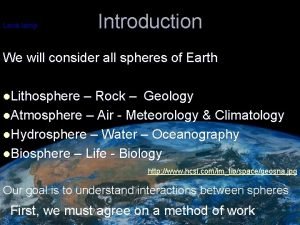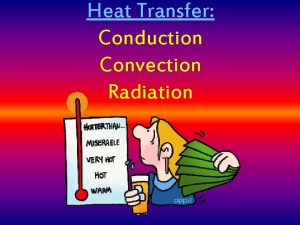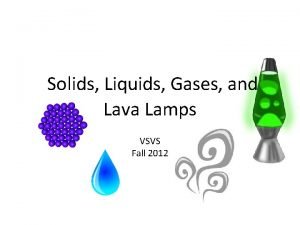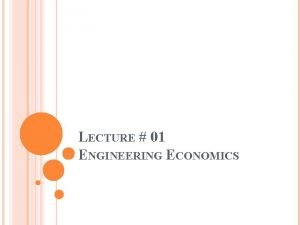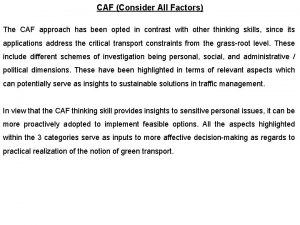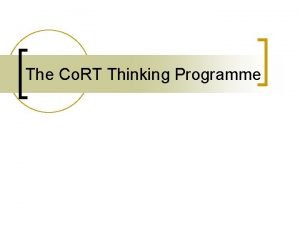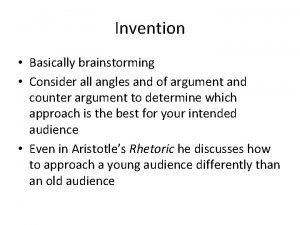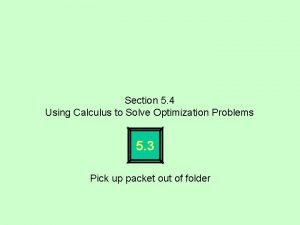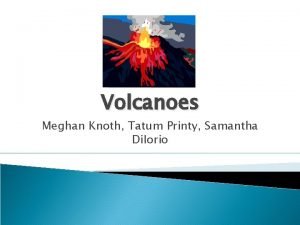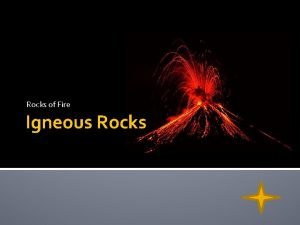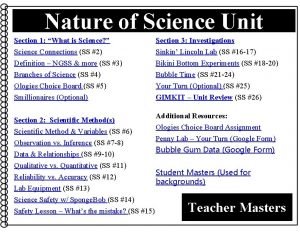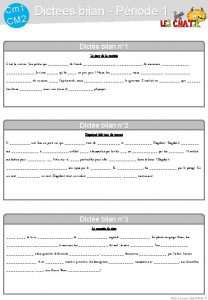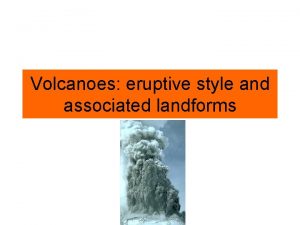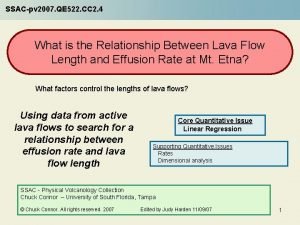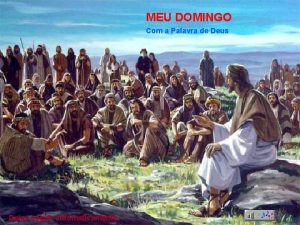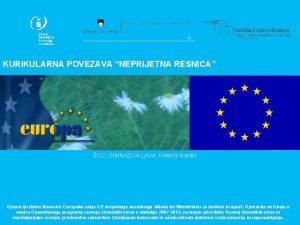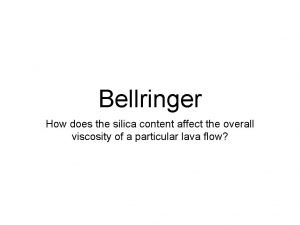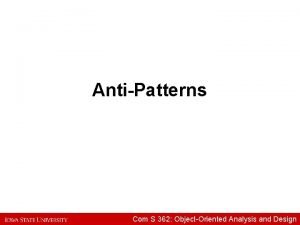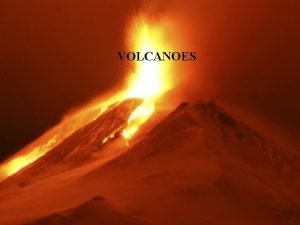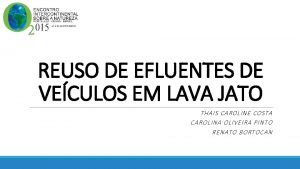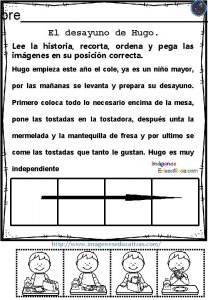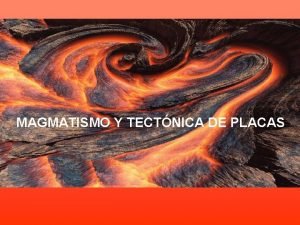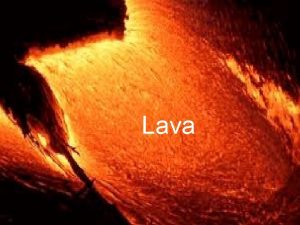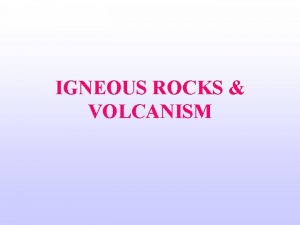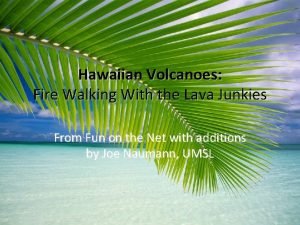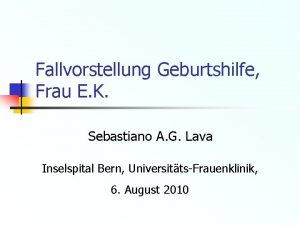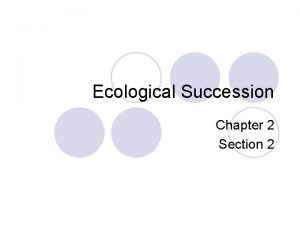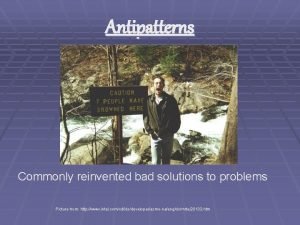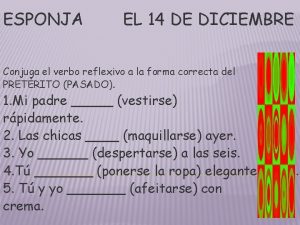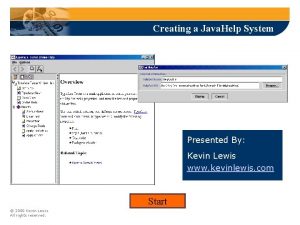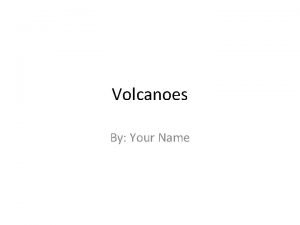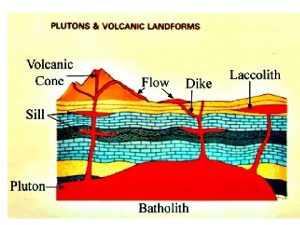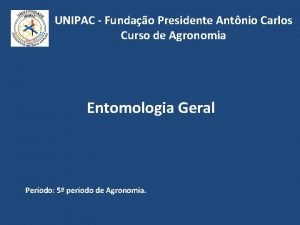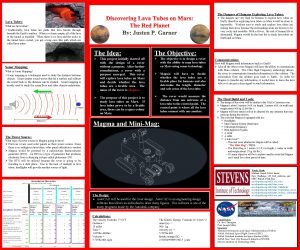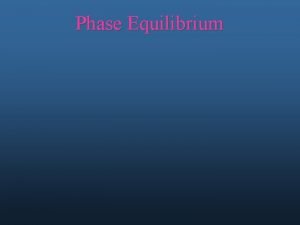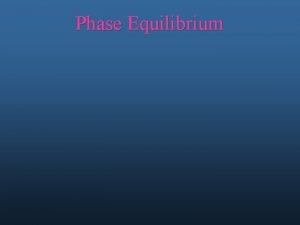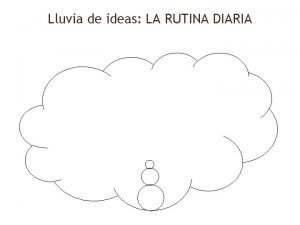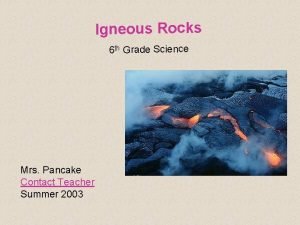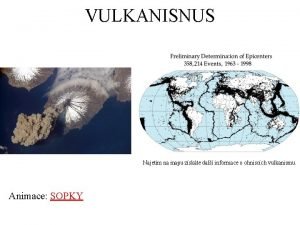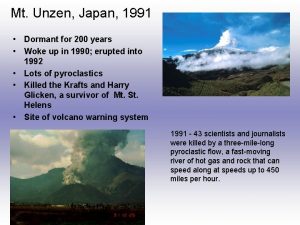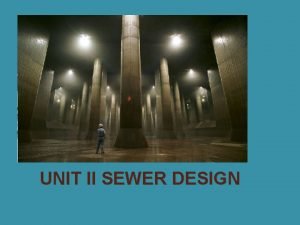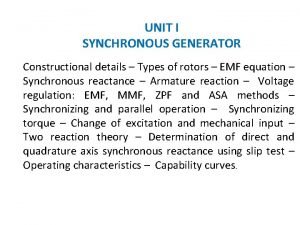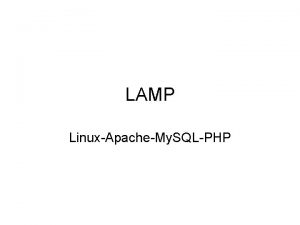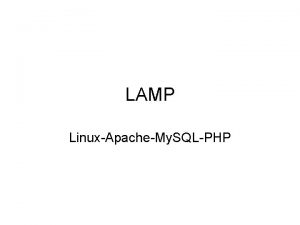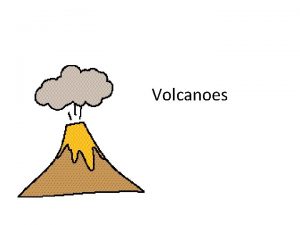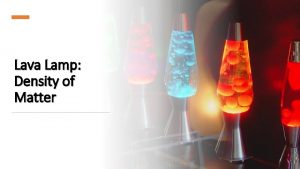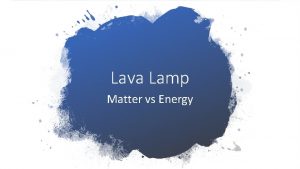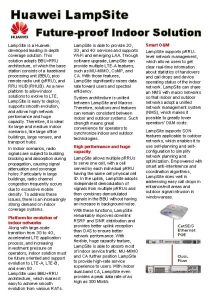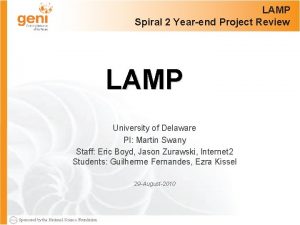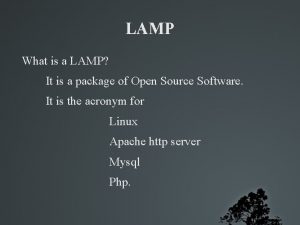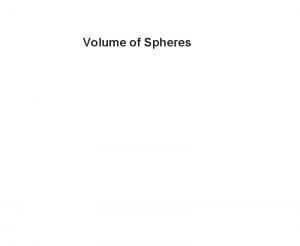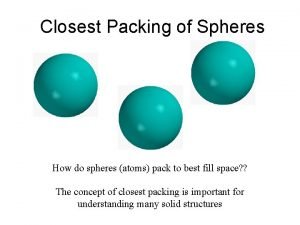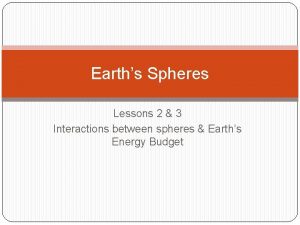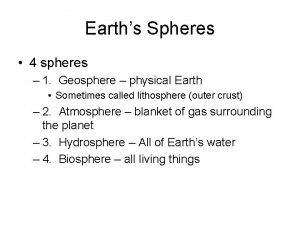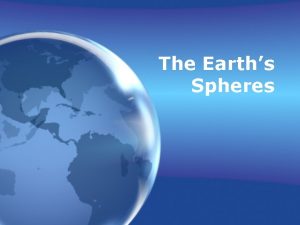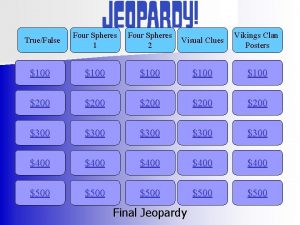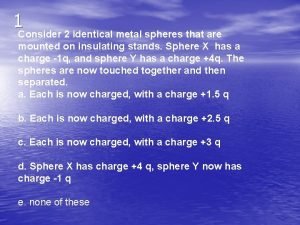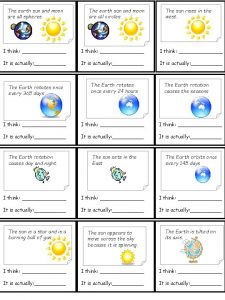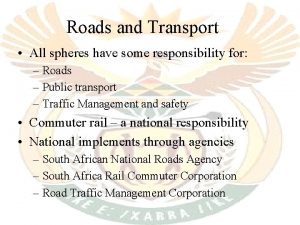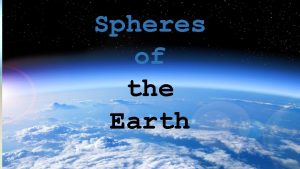Lava lamp Introduction We will consider all spheres

























































- Slides: 57

Lava lamp Introduction We will consider all spheres of Earth l. Lithosphere – Rock – Geology l. Atmosphere – Air - Meteorology & Climatology l. Hydrosphere – Water – Oceanography l. Biosphere – Life - Biology http: //www. hcsi. com/im_lib/space/geosna. jpg Our goal is to understand interactions between spheres First, we must agree on a method of work

Scientific Method • Hypothetico-deductive framework • Hypotheses have testable consequences • We test hypotheses to try to falsify them • Karl Popper http: //www. eeng. dcu. ie/~tkpw/ 1934 Popper Logic of Scientific Discovery Falsification

biography of Book: The_Structure_of_Scientific_Revolutions (1962) • Paradigm shifts

http: //en. wikipedia. org/wiki/Aristotle An example: The earth’s orbit • The Greek philosophers including Aristotle (384 BC - 322 BC ) observed the Sun rising in the east and setting in the west and inferred that the Sun revolved around Earth in a geocentric (Earth-centered) orbit.

Galileo's Letter to the Prince of Venice http: //www. mira. org/fts 0/planets/099/text/txt 002 x. htm

Aristotle’s model is wrong Europa Io • Galileo’s observations of the orbits of Jupiter’s four largest satellites revealed that the Aristotle-Ptolemy model is unbelievable • Objects that do not orbit the Earth • We now know that the planets, including the Earth, orbit the Sun Callisto Ganymede http: //www. hcsi. com/im_lib/imlib_space. html http: //www. enchantedlearning. com/subjects/astronomy/planets/jupiter/moons. shtml

A new law Isaac Newton (1665) discovered the force that held the planets in their orbits around the sun gravity. l gravitation, "every body in the universe attracts every other body. “ l Force = mass x acceleration = ma identify symbols l Gravitational Force = gm 1 m 2/r 2 l Both orbit, but … l Sun is much more massive, appears to hold still while the earth orbits around it. l We will see “g” again

How Far Away? • We use the speed of light to indicate distance – light years 9460 billion kilometers • Nearby Cepheids (variable stars) maximum brightness varies with period • Measure apparent brightness and get distance of far away Cepheids • Our galaxy, the Milky Way, is 100, 000 light years across (diameter)

Continuous, Emission and Absorption Spectra White light contains a continuum of colors from short wave violet to long wave red Hot, dense materials emit discrete "emission" spectra Hydrogen When light with a continuous spectrum passes through a cold, rarefied gas, an absorption spectrum results. Each gas absorbs the same wavelengths that it emits when it is hot. The spectrum of the light from our Sun is an Absorption spectrum. Helium

Redshift: absorption spectra shift to red with retreat of the emitter Analogy: Passing train whistle, high to low frequency = short to long wavelength “Doppler Effect”

Blue, moving toward us Very distant objects aren’t just single stars, those are galaxies of stars! Hubble: What if their colors reflect their speed and direction? Red, very distant, moving away fast Hubble Space Telescope

http: //en. wikipedia. org/wiki/Edwin_Hubble The Hubble Redshift • Hubble discovered that the most distant galaxies with Cepheids had their light shifted to the red end of the spectrum. This meant that they are moving away from us. red and far object • Hubble: Turn this into a. Very new yardstick: the redder the shift, the further the galaxy • Result: the edge of the universe (furthest objects we can detect) is approximately 15 billion light years away. http: //skyserver. sdss. org/astro/en/proj /advanced/hubble/conclusion. asp

Origin of the Universe l The spectral shift of light coming from distant galaxies tells us that the universe is expanding out of a very small volume that began at most 15 billion years ago l Estimates vary according to method l The universe expanded from a state of pure energy, hydrogen atoms condensed from energy in a process called nucleosynthesis E=mc 2

Origin of the Elements • Very small volume expands “Big Bang” • A few minutes energy cools to form H • Hydrogen gas clouds condensed to form main sequence stars. • H fuses to form He and heavier atoms • “Main sequence stars” form Oxygen and Carbon. Water = 2 Hydrogen + 1 Oxygen H 2 O Symbols for elements

Origin of Heavy Elements • A star more than 8 -20 times the mass of our sun burns faster, then expands into a red super giant star, similar to Betelgeuse. • Pressure is high enough to also produce the heavier elements including silicon Si, magnesium Mg, iron Fe. • Once its fuel is exhausted, a supernova explosion occurs. http: //www. solarviews. com/cap/ds/betelgeuse. htm

8 14 Most rocks are made of these two Main Sequence Stars Super Giant Stars

Origin of Our Solar System • Our solar system with its abundant collection of heavier elements condensed from the gas cloud left after the explosion of a supernova.

Supernova ejects matter-rich pressure waves into space Local concentrations of dust coalesce Balance between gravity and solar wind

During coalescence: Particles assemble due to gravity – heat up Iron melts and begins to sink Lighter materials concentrate closer to surface 1_7 Planetesimals strike growing Earth 1. Rub your hands together. Motion (“kinetic”) energy is converted to heat. DIFFERENTIATION Crust and mantle Liquid core Atmosphere Crust Mantle Outer core Inner core The moon formed after a Mars-sized planet hit earth, about 4. 6 bya We got most of the core material in the exchange

Earth’s Internal Structure • Earth’s internal layers defined by – Chemical composition – Physical properties – Deduced from Seismographs of Earthquakes – Meteorites lend support • Layers defined by composition – Crust – Mantle – Core Iron-Nickel Meteorite

Earth’s internal structure • Main layers of Earth are based on physical properties including mechanical strength • Outer layers mostly Silicate Minerals: Crust and Mantle • Lithosphere (behaves like a brittle solid) Crust and uppermost mantle • Asthenosphere “weak sphere” Rest of Upper Mantle Heat softened, plastic solid • Lower Mantle Solid due High Pressures • Inner Layers Core Iron and Nickel, outer core hotter than melting point - liquid, inner core solid due to high pressures

CRUST (least dense) Upper mantle Note progression of densities MANTLE Oil and water Continental crust Oceanic crust 1_8 0 km ~100 km ~350 km Lower mantle Lithosphere Asthenosphere CORE (most dense) Outer core ~5155 km Inner core ~2900 km Conversion Factors 6370 kilometers to the center of the Earth 6370 km x 5 miles/8 km = 3981. 25 miles Earth has a radius of about 4000 miles

Liquid Outer Core causes Magnetic Field “Lithosphere” “Asthenosphere” Earth has a large liquid outer core, makes a magnetic field, and so a thick atmosphere

The Magnetic Field protects the Atmosphere. The Atmosphere protects Earth from most meteors Origin of magnetic field: the liquid outer core

An Important Magnetic Field A magnetic field once surrounded Mars. The red planet lost its protective magnetic field as the smaller planet cooled down more rapidly than Earth, losing its hot liquid core. Mars retains just isolated remnants of its atmosphere where pockets of relict magnetism remain.

A Perfect Spot § Earth's distance from the Sun allows water to exist as a liquid. § The biosphere of Earth has moderated the composition of the atmosphere to make it more suitable for life. Vegetation absorbed large volumes of carbon dioxide and produced oxygen O 2 and Ozone O 3. § Earth's atmospheric gases protect the planet from all but the largest incoming space projectiles (comets, meteorites) and ozone blocks harmful ultraviolet radiation from the Sun

The Geothermal Gradient n n n The temperature gradient in the crust averages approximately 25 o. C per kilometer. Varies with location (higher in areas of volcanic activity) and depth Shows the interior of the planet is much hotter than the exterior. Volcanism an indication that heat is being transferred from the interior toward the surface. Heat transfer occurs by convection, radiation and conduction. (define)

From the Asteroid Belt to Earth • The gravitational attraction of Jupiter , or passing comets, jostles asteroids from their asteroid belt orbits causing collisions • Sends asteroids toward the inner planets. Barrington Crater Winslow, Arizona • Impacts with earth, moon and terrestrial planets have left scars that can still be observed today

Comets – dirty snowballs – are jostled loose from the Oort Cloud and fall toward the Sun A Dirty Comet Impact in 1908 -- No Crater 2100 km 2 flattened http: //en. wikipedia. org/wiki/Tunguska_event The Tunguska Event • Had the object responsible for the explosion hit the Earth a few hours later, it would have exploded over Europe (most probably Scandinavia) instead of the sparsely-populated Tunguska region, producing massive loss of human life and changing the course of human history

K-T Mass Extinction A Crisis in the History of Life n Cretaceous-Tertiary extinction claimed dinosaurs, flying reptiles, marine reptiles, and many marine invertebrates

Chicxulub impact structure on the Yucatan Peninsula, Mexico 65 mya this event placed dust in the atmosphere and started fires that killed 70% of all species The dust is found in a thick layer worldwide, and forms the K|T boundary the boundary between the Age of Reptiles and the Age of Mammals. Gravity Map http: //en. wikipedia. org/wiki/Chicxulub_Crater

The KT ash layer in Alberta Shocked Quartz Luis and Walter Alvarez

The consequences of a Chicxulub • Powerful air blast flattens everything for thousands of square kilometers • Massive earthquake 100 to 1000 x greater than historical times • Deep crater 10 -20 x object diameter • Massive plume of dust into atmosphere. blocking sunlight • Lower temperatures and a short-term cooling trend. • Earth in darkness prevents photosynthesis for the next year. • Vegetation would not survive • Colossal wildfires that would add smoke to the rapidly darkening skies. • Giant tsunami waves with heights up to 2 miles) would be possible from a Chicxulub-sized event in the deep ocean.

NASA's annual budget for detection of NEOs: $3 million One superfund cleanup $21 million The End of the Age of Reptiles 65 million Years Ago

Okay, that’s enough background. During WWII ships with depth sounders crisscrossed the earth’s oceans The Geology Paradigm What is That?

Continental drift: An idea before its time • Alfred Wegener • Proposed hypothesis in 1915 • Published The Origin of Continents and Oceans • Continental drift hypothesis • Supercontinent Pangaea began breaking apart about 200 million years ago

South American and African Coastlines Fit Fossils, mountain ranges, glaciers

Harry Hess The revolution begins • During the 1940 s and 1950 s technological advances permitted mapping of the ocean floor. Hess was captain of a minesweeper with sonar. Left it on all WWII. • Seafloor spreading hypothesis was proposed by Harry Hess in the early 1960 s. http: //www. amnh. org/education/resources/rfl/web/essaybooks/earth/p_hess. html Remember Arthur Holmes

Convection, the basic idea of Plate Tectonics, Atmospheric Cells, and Ocean Currents http: //www. gfdl. noaa. gov/~io/Bubble. html Start with a hot bubble, it expands and so is less dense. It rises as surrounding dense material presses on it, especially at deeper, higher pressure, levels. When it hits a barrier it spreads, cools and becomes denser. It sinks and returns material to the start. Bubble Convection ( i. e. the lava lamp model)

Harry’s Idea: Sea-Floor Spreading 1_20 Convection cells in the hot mantle hit the lithosphere barrier. They spread out and cool, pulling the lithosphere apart. New lava gets into the cracks, filling the gap, and FORMING NEW OCEAN CRUST! Mid-ocean ridge

How Can We Test Harry’s Hypothesis? Some mineral crystals in solidifying lava align with Earth’s magnetic field. Tilt tells latitude. Earth’s North –South Poles can flip. Tilt will change direction New lava rock will have the signature of the magnetic field when it froze

Fred Vine and Drummond Matthews: Harry’s idea is A TESTABLE HYPOTHESIS Paleomagnetic reversals would be recorded by lava (called basalt) at mid-ocean ridges New lava rock will have the signature of the magnetic field when it froze

Maps of Magnetic Stripes in Oceanic Crust Princeton Post. Doc Fred Vine and Drummond Matthews Did they prove Harry’s idea?

Harry Hess’s Seafloor Spreading developed into Plate tectonics: The new paradigm • More encompassing theory than Wegener’s continental drift • Explains motion of Earth’s lithosphere by seafloor spreading (creation of new ocean floor) and subduction (destruction of old ocean floor) • All major earth features are explained

The Asthenosphere boils, like soup. This moves the cold Lithosphere PLATES above Lithosphere is "the scum floating on top of the boiling soup" Here we see Divergent Margins (the Atlantic Mid-Ocean Ridge – Harry’s Sea-Floor Spreading) and Convergent Margins (the dense Pacific Ocean Plate is being dragged under South America – called subduction zones )

Continental Lithosphere Oceanic Lithosphere Asthenosphere Subduction Zone

Divergent Boundaries (Rising Convection Currents) Mid-Ocean Ridge Convergent Boundaries (Descending Convection Currents) Subduction Zone Mantle material rises, ponds under the lithosphere, spreads, pulls the lithosphere apart. Mantle minerals exposed to low pressures. Some mantle minerals are unstable at low pressures. They melt, forming lavas, which get into the cracks, and cool into basalt, the main rock of ocean lithosphere.

180º 90º 180º Mid-Atlantic Ridge 1_15 45º NORTH AMERICAN PLATE JUAN DE FUCA PLATE ARABIAN PLATE CARIBBEAN PLATE COCOS PLATE 0º PACIFIC PLATE NAZCA PLATE 45º PHILIPPINE PLATE 0º FIJI PLATE Mid-Atlantic Ridge INDIANAUSTRALIAN PLATE 45º ANTARCTIC PLATE Convergent plate boundary Divergent plate boundary Transform plate boundary PACIFIC PLATE AFRICAN PLATE SOUTH AMERICAN PLATE SCOTIA PLATE 180º 45º EURASIAN PLATE ANTARCTIC PLATE 90º 0º 90º 180º Seven or so major plates, about an equal number of small plates

Components of Plate Tectonics: there are three main types of plate margins Divergent, Convergent and Transform Each plate bounded by combination of all three boundary types

Divergent boundaries are located mainly along Mid-Ocean Ridges (MORs)

The East African Rift MORs can start as rift valleys, the dry land precursor of mid-ocean ridges. Soon enough they connect to the sea, and flood, forming a new ocean

Convergent Plate Boundaries If Seafloor Spreading (Divergence) is occurring somewhere, plates must push against one another in other areas LATE NTAL P E N I T N O C TE AL PLA T N E N I CONT Oceanic lithosphere being subducted (a) Subducted Ocean Plate loses water and adjacent Mantle partially melts, new buoyant magma rises to the surface, forming a Volcanic Arc such as the Andes Mountains of South America

Once the ocean crust between them is subducted, the continents collide. Both are thick and made of buoyant (low density) minerals, so neither continent can be subducted under the other Collisional mountains Rocks deformed in collision (b) Collisions formed the Appalachians, and, more recently, the Himalayas and the Alps. Suture

The collision of India and Asia produced the Himalayas 1. Subduction Zone Phase 2. Collision Phase

Convergent Boundaries Types Products Ocean-Continent Andes, Cascades Favorite quiz picture Ocean-Ocean Japan, Aleutians Asia India Continent-Continent Himalayas, Alps, Appalachians

Transform Plate Boundaries Transform Margins accommodate movement as plates slide past one another, for example the San Andreas Fault and between Mid. Ocean Ridge segments

Plate Tectonics Explains It All • The Plate Tectonic concept caused the realization that Earth’s many geologic features were all caused by the same process. • We now understand mountains, volcanoes, and big earthquakes associated with, for example, the San Andreas fault. • We understand rift valleys and how oceans form, deep ocean trenches, mid-ocean ridges, and why fossils and mountain ranges look alike across vast oceans.
 Perbedaan hot lava dan hot lava volcano
Perbedaan hot lava dan hot lava volcano Ocean floor lava lamp
Ocean floor lava lamp Type of thermal energy transfer
Type of thermal energy transfer Lava lamp experiment explanation
Lava lamp experiment explanation Energy transformation song
Energy transformation song Interu
Interu Name
Name Consider all relevant criteria
Consider all relevant criteria Consider all factors
Consider all factors Edward de bono pmi
Edward de bono pmi Consider all angles
Consider all angles The sum of two nonnegative numbers is 20
The sum of two nonnegative numbers is 20 Lava and magma difference
Lava and magma difference Defintion of magma
Defintion of magma Gimkit floor is lava world record
Gimkit floor is lava world record Volcano introduction
Volcano introduction How do lava lamps work
How do lava lamps work Dictée la montée de sève
Dictée la montée de sève Yellowstone caldera formation
Yellowstone caldera formation Lava flow
Lava flow Jesus lava pés
Jesus lava pés šcc gimnazija lava
šcc gimnazija lava Chapter 18 volcanic activity
Chapter 18 volcanic activity How does silica affect lava
How does silica affect lava Lava flow antipattern
Lava flow antipattern Opening in the earth's crust where magma occasionally exits
Opening in the earth's crust where magma occasionally exits Rocce sialiche
Rocce sialiche Caixa de decantação lava rapido
Caixa de decantação lava rapido El desayuno de hugo
El desayuno de hugo Lava vacuolar
Lava vacuolar Hoe maak je lava
Hoe maak je lava Solidified lava rock family
Solidified lava rock family Photographer on lava
Photographer on lava Significado de palabras por contexto
Significado de palabras por contexto Druckindolent
Druckindolent Steps of secondary succession
Steps of secondary succession Blowhard jamboree
Blowhard jamboree What is a mountain
What is a mountain Ts lava
Ts lava Verbos reflexivos secarse
Verbos reflexivos secarse What is lava
What is lava What is lava
What is lava Montagne pelée aiguille
Montagne pelée aiguille P wave
P wave Lava plateau diagram
Lava plateau diagram A dome mountain forms when _____.
A dome mountain forms when _____. Lava plateau diagram
Lava plateau diagram Formigas lava pés
Formigas lava pés Sebastiano lava
Sebastiano lava Makaopuhi lava lake
Makaopuhi lava lake Makaopuhi lava lake
Makaopuhi lava lake El muchacho _____ uniforme a la escuela.
El muchacho _____ uniforme a la escuela. Lava magma
Lava magma Italská sopka křížovka
Italská sopka křížovka Lava domes
Lava domes Woodson bridge sra
Woodson bridge sra Sewer appurtenances
Sewer appurtenances Impedence method
Impedence method

